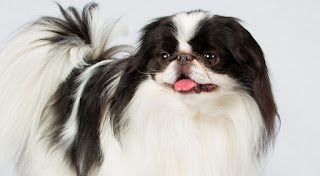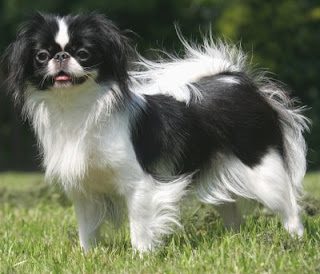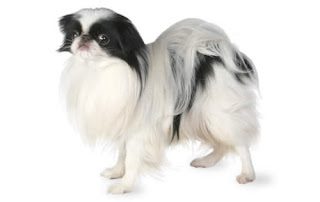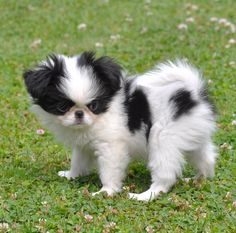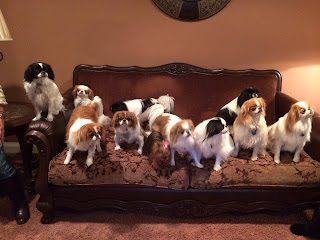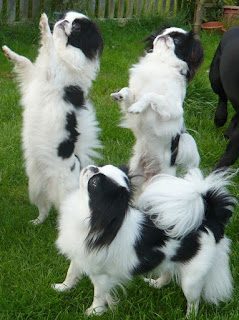- In Japan, the Chin is considered a higher being than other dogs.
- Chin love to go for walks, but they’re not fond of inclement weather. It’s a good idea to papertrain a Chin if you live in an area with a lot of rain or snow.
- When the Chin isn’t playing, he’s perching on a high point, observing everything going on around him.
- The Chin’s happy, cheerful nature, adaptability and range of sizes make him suited to almost any home. Chin who weigh eight or nine pounds are best for families with children, but they must still be handled carefully.
- The Chin’s abundant silky coat comes in black and white, red and white, or black and white with tan points (tricolor).
- Because of his acrobatic nature, climbing ability, and tendency to clean himself, the Chin has been described as a cat in a dog suit.
AKC group: Toy
UKC group: Companion/Spaniel
Average lifespan: 12 – 14 years
Average size: 4 – 7 pounds
Coat appearance: Silky, straight and luxurious
Coloration: White with black patches, ruby and white
Hypoallergenic: No
Other identifiers: Body is same length as height; wide-set, large eyes; small V-shaped ears covered with hair; typical black nose with like-colored markings; straight legs; tail set high with feathering
Possible alterations: Patches of color may be red, brindle, orange and other similar colors; markings will match the coloration of the noseComparable Breeds: Pekingese, Shih Tzu, Pug
History
The Japanese Chin is an ancient breed that probably originated in the Chinese imperial court. Highly prized, he was often given as a gift to emissaries from other lands, and it was probably as a gift to the emperor of Japan that he made his way to that island nation which gave him his name. In Japan, the Chin was regarded not as a dog (inu) but as a separate being (chin). There, he was probably crossed with small spaniel-type dogs and eventually achieved the look he has today.
The Japanese Chin remained unknown to the outside world until 1853 when Commodore Matthew Perry sailed into Uraga Harbor near Edo — now modern-day Tokyo — and introduced Japan to international trade. The Japanese Chin became a popular commodity and many were imported into Britain and the United States.
Among the first American owners of the breed were President Franklin Pierce, then-Secretary-of-War Jefferson Davis, and Perry’s daughter, Caroline Perry Belmont. They became popular with people of wealth and nobility. In the United States, the Japanese Chin was known as the Japanese Spaniel and he kept that name until 1977.
This breed is considered one of the most cat-like of the dog breeds in attitude: it is alert, intelligent, and independent, and it uses its paws to wash and wipe its face. Other cat-like traits include their preference for resting on high surfaces, their good sense of balance, and their tendency to hide in unexpected places. Japanese Chin are loyal to their owners and are typically a friendly breed. While Japanese Chin prefer familiar surroundings, they also do well in new situations. This, alongside their friendly demeanor, makes them good therapy dogs. Early socialization of Japanese Chin puppies leads to a more emotionally well-balanced Chin that is more accepting of different situations and people.
Japanese Chin are defensive animals and thus although they are usually quiet, they will bark to alert the arrival of a visitor or to draw attention to something out of the ordinary.
Japanese Chin were also bred for the purpose of entertaining their owners. While typically calm, they are well known for performing many tricks such as the “Chin Spin”, in which they turn around in rapid circles; dancing on their hind legs while pawing their front feet, clasped together, in the air; and some even “sing”, a noise that can range from a low trill to a higher, almost operatic noise.
Health
The Japanese Chin, with an average lifespan of 10 to 12 years, is prone to minor ailments like patellar luxation, cataract, heart murmur, Keratoconjunctivitis Sicca (KCS), and entropion. Achondroplasia, portacaval shunt, and epilepsy are sometimes seen in this breed. The Japanese Chin is also susceptible to corneal abrasions and cannot tolerate anesthesia or heat. Knee and eye tests are recommended for this breed.
Japanese Chin require very little exercise. They are happy with a daily walk or a nice play session but they tend to require little else. Training can be slightly difficult since they have a mind of their own and become bored with repetitious training. When they like you, however, they’ll work hard to please you. When they do wrong, a firm tone of voice is all you need to set them straight. Stronger corrections will only backfire and cause your Chin to stubbornly stand his ground.
They can be difficult to housetrain but with patience and consistency, you can generally expect them to be housetrained by 4 months of age.
Japanese Chin are companion dogs and should not live outdoors or in kennels. They become very attached to their people, and many suffer from separation anxiety. With their low exercise needs, Japanese Chin make wonderful apartment residents.
The neck of the Japanese Chin is very delicate and it is strongly suggested that you use a harness instead of a collar when walking him.
Living Conditions
The Japanese Chin is a good dog for apartment life. They are moderately active indoors and will do okay without a yard. This breed is somewhat sensitive to temperature extremes.
Japanese Chins have spaniel roots, making them easier to train than other small breeds. Training should be done with nothing but positive reinforcement, as harsh treatment will bruise their sensitive egos and they will simply stop listening. The daily training routine should be mixed up to keep the Chin interested, as he is easily bored with repetitive activities. Once basic obedience is mastered, teaching your Chin do to parlor tricks is a breeze, and he’ll love the attention that gets lavished upon him when guests see him perform.
Exercise
Chins do not require a great deal of exercise, however they do need to be taken on a daily walk. They will enjoy the opportunity to play in an open yard.
Grooming
The Chin might look like he needs a lot of grooming, but he’s a wash-and-go dog. His silky, abundant coat is easy to care for and rarely mats, with the occasional exception of the ear fringes. Brush him weekly with a pin brush to keep the hair from flying around the house (yes, the Chin sheds), and bathe him once a month to keep him smelling nice. After a bath, towel him off until he’s almost dry, brush the coat upward and outward with the pin brush, then smooth it down. You’re done!
The rest is basic care. Trim the nails as needed, usually every week or two. Toy breeds are especially prone to periodontal disease, so brush the teeth frequently with a vet-approved pet toothpaste for good overall health and fresh breath.
Although the Japanese Chin is a gentle dog, he is not recommended for homes where there are young children. He can be easily hurt by an overexuberant child. The breed does well with older children who understand how to properly handle a dog.
As with every breed, you should always teach children how to approach and touch dogs, and always supervise any interactions between dogs and young children to prevent any biting or ear or tail pulling on the part of either party. Teach your child never to approach any dog while he’s eating or sleeping or to try to take the dog’s food away. No dog, no matter how friendly, should ever be left unsupervised with a child.
Japanese Chin get along well with other dogs and cats, but they must be protected from larger dogs who could accidentally injure them in play. A cat’s claws can injure their large eyes, so it’s important to make sure everyone plays nicely together.
Is this breed right for you?
Very friendly, the Japanese Chin fits in well with any family. Due to his delicate nature, it is best that children are taught how to handle the small breed. Good with other animals, he’s an indoor dog that can live well in an apartment. Needing only moderate exercise, he’ll be content with short walks around the neighborhood. The Japanese Chin is easily trained, enjoys playtime and is best kept out of the heat for a prolonged period of time. His luxurious coat will need to be groomed twice a week and it’s best to socialize and train him to know that you are master to avoid any potential behavioral problems.
Did You Know?
A Japanese Chin makes a cameo appearance in the 1984 Woody Allen film “Broadway Danny Rose.”
A dream day in the life of a Japanese Chin
The Japanese Chin will ideally wake up in the bed of his master. Following the family wherever they may go, he may stop for a trick or two while awaiting his meal. After a bit of TV time with his master, the dog will enjoy a quick stroll around the neighborhood. Upon returning home, he’ll be happy to hang out with the little ones of the house until bedtime, where he’ll contentedly snuggle up to his humans.
